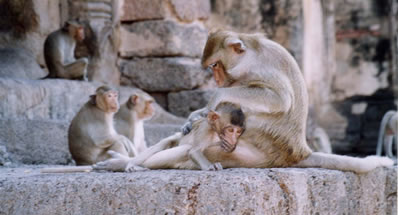
By

 Anyone who has ever travelled to Lopburi would agree — the town needed a monkey hospital (or rongpaiyaban ling , as the Thais would say).
Anyone who has ever travelled to Lopburi would agree — the town needed a monkey hospital (or rongpaiyaban ling , as the Thais would say).
It was just one of those things. A visit to the town's main intersection during the evening rush hour confirms this, hundreds of hungry monkeys making their way from the Phra Prang Somyod Sanctuary to the Phra Karn shrine. Not only do they have to dodge cars, trucks, buses, pick-ups and motorcycles, but trains as well, since the railway runs through the centre of town. Then, if they make it through the traffic, they start swinging from the nearest electrical lines, a practice which unfortunately leads to electrocution among some of them.
The monkeys have a number of problems to cope with — babies being dropped or falling from the tops of the temples, trees or power lines; bites and attacks from competitors during territorial wars; injuries suffered from traffic accidents; electrocution; and leprosy.
But now the town has a place where these monkey casualties can be properly treated. Lopburi has the world's first monkey hospital. Previously, monkeys were treated at the overworked Lopburi Zoo. On any given day, that could involve as many as 10 sick monkeys—too many, especially since the zoo has to care for all of its other animals as well, besides which diseases from the monkeys can spread to other animals. So the idea for the hospital evolved under the guidance of zoo director Smorn Srithundorn.
 Lopburi can have as many as 2,000 monkeys running around the centre of town on any given day. Where did all these monkeys come from?
Lopburi can have as many as 2,000 monkeys running around the centre of town on any given day. Where did all these monkeys come from?
Originally they ventured forth from their jungle home to the city square back in the 1680s, in the time of King Narai, when Lopburi was Thailand's second capital. The monkeys gravitated towards the local shrine for Phra Karn, the Hindu God Kala, Lord of Creation and Destruction, and soon became considered disciples of Phra Karn. From early on, they were thought to carry the spirit of Phra Karn, so no one messed with them. And for centuries now, the human and simian inhabitants of Lopburi have peacefully co-existed. The main problem used to be how to care for them once they got sick.
Three main groups of monkeys in town include crab-eating monkeys, rhesus macaques and cross-breeds between the two. The first group, ling san phra karn , number about 800 and they tend to hang around the shrine. The second group, ling prang somyod , are so named for the main temple in town, where about 1,000 of them congregate. Both of these groups are very well treated, with local people feeding them twice a day. They are also quite bright, and can easily open Tetra Pak milk and yoghurt containers. Since these monkeys know they will be fed regularly, they don't try and steal food from locals or tourists.
The third group, the ling tuk (building monkey) or ling talad (market monkey), number about 350, and live on buildings around Phra Prang Somyod, subsisting on leftovers from households and neighbourhood shops. They were originally grouped with the Phra Karn monkeys, but rumour has it a half-blind dominant male led this splinter sect away from the shrine to the more luxurious amenities of city life. This group tends to be the most susceptible to leprosy, since they don't clean themselves and only hang out in and around buildings so, if they do get an open wound, they're more prone to infection. These monkeys can also get into a heap of trouble during invasions of human dwellings by swallowing disinfectants, detergents and other poisonous substances common in most homes. (Lopburi supermarkets have yet to come up with monkey-proof products.) They tend to be the biggest nuisance of the three because they break things in the course of their scavenging.
A number of the monkeys from all three groups have taken to hitching rides on trains as they pass through town, and some have even been known to journey as far as Nakhon Sawan.
In-fighting among the three is fierce, and can even result in fatalities. They pretty much leave each other alone, but if a monkey from one group crosses into another monkey's territory on an unwarranted venture, they will have hell, or Phra Karn, to pay. The two main groups do move back and forth between each other's territory, but only when the dominant monkeys sense it's okay, and the “home” group tolerates the venture into a certain part of its territory, usually for feeding purposes.
One of the main problems the hospital encounters is simply catching the sick monkeys so it can treat them. Hospital staff who try and retrieve the monkeys are treated like kidnappers by other monkeys, and can be bitten in their rescue efforts.
Veterinarians Ms Jutumas Supanam and Mr Somsak Naksomboon and their assistants run the new monkey hospital. They have had to treat up to 10 monkeys a day, but are usually not that busy. When we visited her, Jutumas was tending to two monkeys, one who had been electrocuted and whose face was terribly scarred. The other, Tanya, born last December, was paralyzed due to a fall. Nourished on a diet of bananas, crackers and milk, Tanya scampers around the hospital on her forelegs, dragging her hind legs behind, and has obviously captured the hearts of the hospital staff.
If any monkeys pass away while in hospital, Buddhist monks perform a cremation ceremony for them and their ashes are wrapped in a white cloth and placed near the base of the zoo's monument to monkeys.
Former Thai Prime Minister Field Marshall P. Pibulsongkram started the Lopburi zoo in 1940. Unfortunately, it later fell into decay, to be revived only in 1977 by the Army's Special War Centre (the zoo sits on army land). It became famous for Mike, the lovesick orangutan it housed. Eventually, a mate named Zu Zu was flown in from Taiwan, and the couple had a young son, Joi. When Mike died last year, he was given a send-off fitting a person of national stature.
There's an obvious economic tie-in to the monkeys, as Lopburians realize. The appealing creatures attract many tourists, both foreign and domestic, and the cash helps the local economy. As a gesture of appreciation, near the end of every year Lopburians stage a feast for the monkeys at Phra Prang Somyod. A sumptuous spread of food featuring watermelon, cabbage, pineapple, peanuts, boiled eggs, bananas, pumpkins and cucumbers is laid out, enough to make many of the human onlookers envious.
Be warned, if you do visit Lopburi, curious young monkeys may jump up on you as you wander around. If this happens, don't panic—they usually won't bite; they're merely trying to find out more about you. Shoo them away, and they'll eventually jump down to scamper away. Angry monkeys behave differently. If, for whatever reason, you tend to incur one's wrath, use whatever defensive measures are necessary but, in general, backing away slowly and speaking calmly will diffuse the situation.
The 8,440-square-foot monkey hospital, located at the back of the Lopburi Zoo, has operating, examination, treatment and admittance rooms. The US$45,000 centre was built with loans and donations from animal lovers. Groundbreaking began 12 August last year, and it was officially opened 2 December 2003. Working hours are 8.30-4.30 daily.
If you want to assist the hospital financially, please send your donations to:
The Wild Animal Rescue Foundation of Thailand/Lopburi,
Thai Farmers Bank,
account #297-2-37336-5
(Wongwien Srakaew Branch).
Lopburi lies 154km north of Bangkok, and is easily accessible by train, bus or car.
FINIS
| Top of the Page |